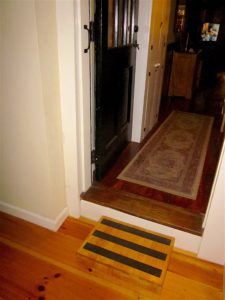Accessibility hacks, mobility aids, and tips (Part 1 of 3)
Written by Paul Shay
Groton, Massachusetts
I am one of the lucky, late-onset FSHers: diagnosed at age 57, now 71. As my progression has been relatively slow over those 14 years, I have incorporated a number of adaptive devices and techniques that I can share with you. Since my wife and I are still working, we have been fortunate enough to have the resources to try out a number of products.
As I am mostly affected in my shoulders, biceps, and quads, my issues revolve primarily around climbing stairs, reaching high and low, and getting up from a seated position.
For those challenges, here are a number of things and tricks I’ve found useful:
Pneumatic Clam-Shell Seat Lift. This device is adjustable for its user’s weight and has modest padding. It allows me to sit at my desk for hours at a time, and gives a gentle boost when getting out of the chair.
Toilevator. This is a sturdy plastic platform onto which your toilet mounts. It comes with all necessary mounting hardware and seals, raising toilet seating height an additional four inches.
Half-Steps. We have a garage with one step up to the porch, and inside, a single step from the entry area to the main level of the house. When these became an issue, I  tried plastic half-steps purchased online. They proved the concept and did help, but were fairly expensive and yet did not last long. Our son then built a couple of rectangular boxed platforms of the same height using quality hardwood. After staining them, he added 3M non-skid strips for traction.
tried plastic half-steps purchased online. They proved the concept and did help, but were fairly expensive and yet did not last long. Our son then built a couple of rectangular boxed platforms of the same height using quality hardwood. After staining them, he added 3M non-skid strips for traction.
For travel, we bought a 12-inch square stepstool and cut the legs off to bring the height down to that of our household half-steps. It fits easily in a suitcase or carry-on, and takes up minimal space.
Otherwise, one of my early purchases was a cane with a small half-step attached to the base. In conjunction with my normal cane, most steps and stairs are now doable thanks to this device.

Where are parts II and III of this article?
Judith, thanks for commenting! We haven’t posted parts II and III yet. I’m glad you like the series!
Thanks for sharing. As a fellow FSHer diagnosed in his 50s and now in my 70s I had to discover on my own most of the hacks that you also discovered. Portable thick foam cushions helped raise seat levels so I could get out of various chairs. I use an outdoor bar chair in the shower. I had grab bars installed in many places. If I got stuck in a couch I found that if I could get a leg up on the arm of the couch I could often then stand up from there. I found walking in zig-zag fashion was useful in going up a hill.
Robert, I’m glad to hear that you’ve found some tricks that help make things a little easier for you. Let us know if you’d like us to send you any of our brochures. Don’t hesitate to reach out if we can help!